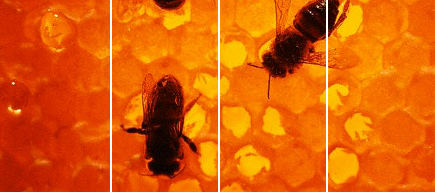 |
 |
Incomplete crystallisation:
The honey is not homogeneous, with a liquid phase including crystals, which are
generally very coarse or aggregated, and attached to the walls and the bottom ofthe jar. This usually occurs in honeyes deficient in one or more factors predisposing to such crystallisation, e.g. honey with a little glucose, immediately jarred after decanting, or remelted honey. |
Separation in stages:
Honey is separated in two parts, one at the surface is liquid, and the other
one is solid. The separation between the two sides is clear and horizontal. It happens for the precipitation of crystals on the bottom due to a consistency of the product which is not enough dense and cohesive: e.g. honey is too humid, with creamy texture, or stored at high temperatures. |
Whitish stripes:
when appearing in the surface (foam), they can be due to the rising of tiny air
bubbles embedded in the mass during processing, or to the formation of carbon dioxide. While the first is only an aesthetic problem, the second case indicates that a process of fermentation is in place: honey in this case is irrecoverable. These two types of defects can be distinguished during tasting: fermented honey has a slightly acid taste.
In case these veins were to be noticed across the surface of the jar, this would be due to the possible expulsion of air occurred during a more or less sudden crystallisation (stains retraction). |
Change of colour:
honey generally subject to excessive heating or kept for too long and in
non-optimal conditions, tend to take a darker color, the typical aromas fade, while a smell and taste of caramel appear together with a more bitter taste due to fructose degradation. |
Fermentation:
The process takes place for the development of yeasts and is perhaps the most
serious and irretrievable defect. Fermented honey has a slightly acid taste. The process of fermentation is directly proportional to the percentage of water: below 18% of moisture the process is blocked. Honey which is fermented or undergoing fermentation is irretrievably lost. The sale is prohibited and the only permitted use is in industry. |
|
 |
|



